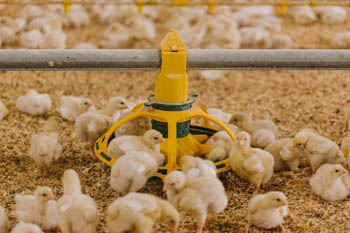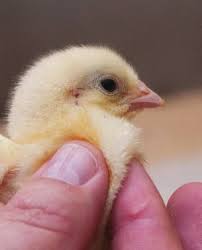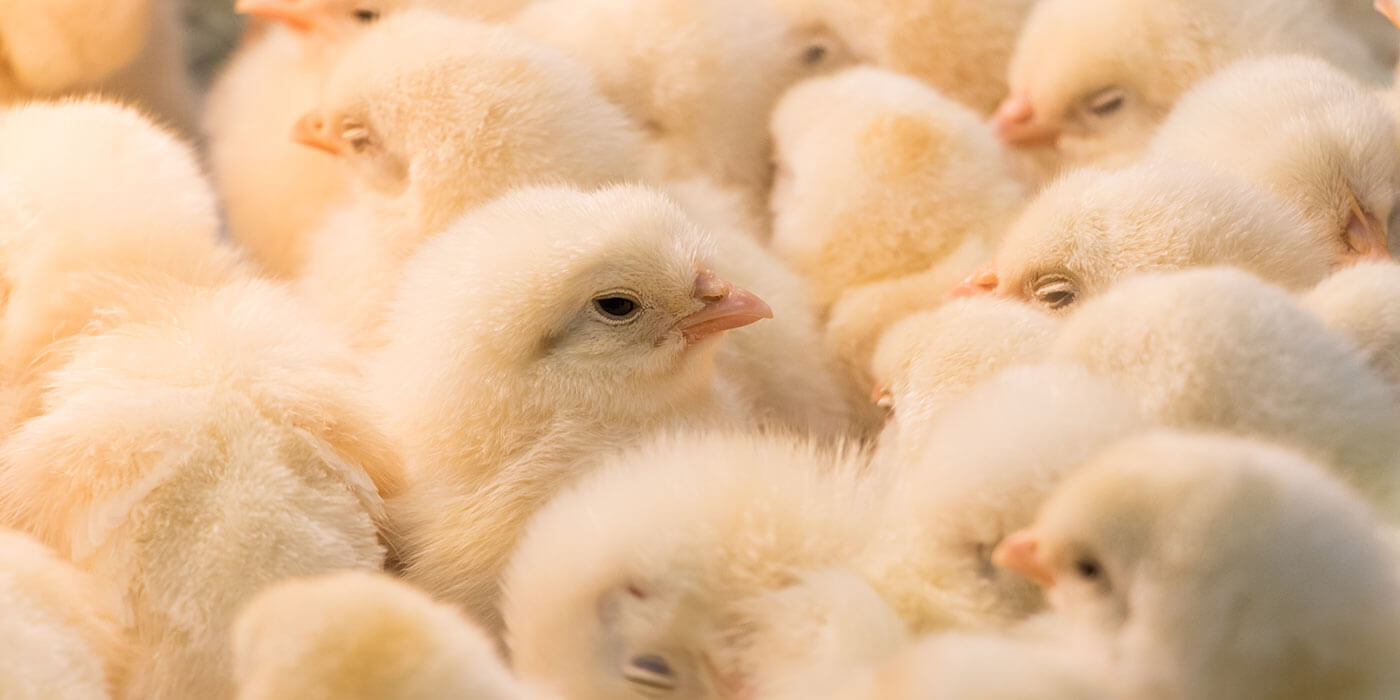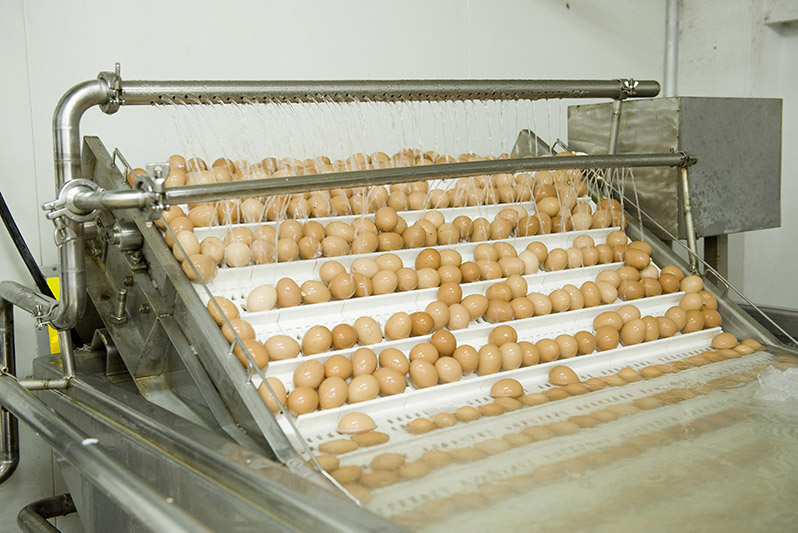Chick Management
Page 08 /
Mortality occurring in the first week of life, especially in broilers, is an important welfare indicator and is a common parameter to assess chick quality.
This FAAST Review will focus on areas and factors that are critical to chick health and performance including:
Housing and Management
When chicks arrive at the housing facility, it is important to ensure that the barn is set up for proper brooding. Chicks will transition from a very tightly controlled and conditioned life at the hatchery to a more independent life at the broiler farm. This means ensuring proper temperature/humidity, excellent water quality and ventilation, and ensuring easy access to feed. With such a short growing period, chick health in the 7 days after placement can really set the stage for performance over the entire grow out period
Another important component for neonatal health and disease control is ensuring, cleaning, disinfection and down time between groups and excellent biosecurity practices when chicks are in the barn. Be sure to check out the Antimicrobial Stewardship in the Canadian Poultry Industry FAAST Review for ‘Ask the Expert’ sections, where we discuss brooding strategies with various members of the industry.
For a great first week monitoring tool for chicks, developed by the University of Montreal, check out:
Chick Champs

Source: BC Chicken Marketing Board
Temperature and Ventilation Management
Chicks raised at lower temperatures that get chilled, are at risk for a higher rate of mortality, mainly due to a disease called ascites, which is a buildup of fluid in the abdomen. In some cases ascites may not kill the bird, but will lead to condemnation at the processing plant.
What’s Appropriate?
Ensuring that housing reaches adequate environmental temperature (at least 29.4°C, with litter reaching 32-34°C) is important to prevent heat loss in the 1st week after arrival to the facility1. Proper ventilation is also critical, to make sure CO2 levels are minimized.
Heat Stress?
In times when heat stress occurs (chick body temperature > 41°C), it is important to take rapid corrective measures, such as increasing ventilation and ensure that water is readily accessible.
What About Humidity?
Humidity is an important aspect of barn temperature and ventilation. Humidity levels in the air should not exceed 70%, and bedding humidity differs slightly depending on substrate. Approximately 50% for straw and 55% for wood chips is ideal. Adjust ventilation levels as needed to achieve this target. This will help to maintain clean and dry litter and prevent chilling of chicks. Humidity levels that are too low will also cause chicks to dessicate (become dehydrated), so ensure that there is plenty of potable water available to the chicks.
Monitoring
Monitor chicks at placement and daily for the first week to monitor their distribution throughout the barn. If they are bunched together, this is an indication that chicks are feeling the effects of cold stress or draughty conditions. Ideally, chicks should be able to invest their energy into growing and maintaining their developing immune system, not trying to keep warm. The ideal situation at brooding is ⅓ resting, ⅓ socializing and ⅓ eating and drinking.
Water Management and Quality
The management of water is an extremely important aspect of chick husbandry. Ensuring that water is clean and free of bacteria is a first step to preventing exposure of newly arrived chicks to unnecessary stress early in life. High levels of certain metals or minerals in water can also have an impact on gut health.
What Should You Monitor?
Some aspects of water quality to monitor include:
- pH: should be 6 or less
- Free chlorine
- Iron levels (excessive levels can lead to biofilm)
- Bacteria levels
Pay Attention to Your Watering Equipment
The type of water dispensing equipment might also be important. Nipple drinkers with a dip cup have been shown to be associated with reduced mortality is likely because the dip cup may provide an area for water to collect allowing for easy and quick access to water which prevents dehydration. Another reason is that nipple drippers with a drip cup provide water from entering the litter which would increase humidity in the litter and barn3.
It is recommended that water lines are cleaned between groups to reduce build up of biofilms and bacteria, and adequately flushed to prevent chicks from being exposed to chemical residues. Have the water analyzed at least annually to help develop a tailored water treatment strategy will foster optimal performance.
Don’t Forget About Placement!
At placement, ensure that nipple drinkers have a drop of water visible, cool water is provided, and nipples are at eye level. When monitoring chicks soon after placement, walking through will help them to locate water. Temporary water trays are recommended to ensure chicks get as much access to water as possible in the first 2-3 days.
Feed Management and Quality
The posthatch chick goes through a significant period of transition where they move from a source of nutrients provided by yolk to an external solid feed diet. Feed in the chick early helps with gut development. It has to be readily accessible for the newly arrived chick, so ensuring that at placement, feed is placed in an area that they are able to reach is extremely important as many chicks that die in the first week do so from starvation.
What Should You Monitor?
Check crop fill every 24 hours for 1 week on a group of chicks. It is also recommended that at least 65 g (2 days worth of feed) be placed per chick. Providing feed on paper or cardboard boxes placed between feed lines and heat sources also helps them to locate it easily, and will prevent them from pecking at litter. During daily monitoring walkthroughs, moving chicks around the barn will help them to locate feed.

Source: Aviagen
Quantity AND Quality
Feed quality is also important as early nutrient inadequacies or nutrient restriction will lead to a lack of growth and an increased susceptibility of disease2. Work with your nutritionist to ensure that a well balanced ration is fed to your chicks.
Disinfection and Biosecurity
Before chicks arrive, ensure that all manure from the previous group is removed, and housing and equipment are thoroughly cleaned and disinfected to prevent disease from spreading between groups.
Thorough Cleaning is the Goal
Beyond just the production area, equipment, boots, coveralls, and anterooms should also be cleaned between crops and during the housing period. In addition, having dedicated boots, coveralls, and equipment for each barn, if multiple barns are used, will also add in reducing transmission of disease between barns.
Water lines should be cleaned and flushed thoroughly between groups. Visitors can also serve as a route to transmit disease. Ensure that biosecurity is maintained for everyone who enters the barn.
For more information, check out the Healthy Environments = Healthy Birds section of the Antimicrobial Stewardship in the Canadian Poultry Industry FAAST Review
Hatching and Breeding
A lot of performance at the broiler farm depends on the quality of chick that is being delivered. Having vigorous and healthy day-old chicks is critical to have a broiler flock that performs efficiently. The quality of the day-old chick depends on the genetic line of the breeders, breeder age and health status, egg storage conditions and duration, egg disinfection, incubation conditions. Quality also depends on the management protocols of the breeder farm with respect to the quality of nutrition and the growth profiles that relate to photo stimulation4. Let’s look at these elements a little closer.
Genetic Line of Bird
Differences between the different genetic strains of broilers have been shown to influence mortality in the first week of life. The strain-related differences in mortality are likely due to differences in egg-weight and embryo metabolic activity that are known to influence chick quality.
Breeder Age and Health Status
There is a higher first week mortality that occurs in both young and older breeders4. Breeder flock health status is also an important contributing factor to chick viability. Certain breeder flock diseases may have vertical transmission (passed from hen to chick), or the disease challenge lowers the robustness (immune function) of the hen, leading to poorer egg development. Imported eggs from the USA may also have an unknown breeder flock health status.
Challenges With Young Breeders
Young breeders produce smaller eggs with less yolk and a thick shell, which causes the weight of live chicks and the yolk sac content to be lower. As the yolk sac is high in fat and protein, chicks from young breeders will have less energy available to them, leading to the reduced viability of the chicks in the first week of life. Special adjustments for chicks from young breeders, in terms of temperature, height of water nipples, and feed ingredients may be needed to overcome this smaller weight at placement and to prevent disease and improve growth.
Challenges With Older Breeders
In older breeders, higher first week mortality could be due to navel and navel-yolk sac infections. In addition, chicks from older breeders hatch sooner, and if chicks are left unattended and the collection time of chicks is not adjusted, the risk of dehydration will increase.
Egg Disinfectants
Disinfectants are a critical part of infection control. If hatching eggs are not sanitized prior to incubation, excessive bacterial contamination and growth will occur, which will lead to decreased hatchability, poor chick quality, growth and performance, and increased mortality. There are many disinfectants to choose from, including both natural and chemical sources, which will decrease bacterial presence on the egg shell8. Work with your veterinarian or other advisors to find a disinfectant that will work best for your farm, as there may be tradeoffs in performance and consequences to utilizing different disinfectants.
Egg Storage Duration
Prolonged egg storage periods will decrease hatchability of eggs and increase incubation time, and decrease chick quality. The reduced quality is likely due to increased embryonic stress, which will damage the embryo and decrease long-term performance. To reduce the effect of storage duration, the use of “Short Periods of Incubation During Egg Storage” or SPIDES technique is used. This technique has been shown to restore hatchability and chick quality, as well as improve growth in the first week of life in eggs stored for more than 7 days3. The SPIDES technique is typically administered at 4-6 day intervals in storage where the eggs are heated to 37.5°C for 4-6 hours6.
Incubation Conditions
The incubation temperature of eggs is an important factor impacting embryo development, hatchability, and posthatch performance. Low egg shell temperatures (< 36.7°C), especially in the first week of incubation will lead to retarded embryo development and lower temperature of the chick after hatching which can predipose them to hypothermia. Studies have found that keeping a consistent egg shell temperature of 37.8°C has been documented to have the best results5.
Losses of water during incubation, due to evaporation, can contribute to higher embryonic mortality and poor chick quality. Water evaporation from the egg can be manipulated by changing the relative humidity, where a higher relative humidity will decrease water loss. To maintain hatchability and chick quality, it is important to maintain water loss between 9.7-12.7%7.
Take Home Messages
- Ensuring optimal chick quality starts with management prior to hatching. The quality of the day-old chick depends on a variety of factors including the genetic line of the breeders, breeder age, egg storage conditions and duration, and incubation conditions
- After hatching, moving chicks into a clean and disinfected environment where they are able to have easy access to water and feed will help to reduce mortality in the first week of life
- Work with your veterinarian and other advisors to create a plan to minimize mortality in the first week of life and improve productivity
References
- Deaton, J.W., S.L. Branton, J.D. Simmons, and B.D. Lott. 1996. The effect of brooding temperature on broiler performance. Poultry Science. 75:1217-1220.
- Vieira, S.L., and E.T. Moran. 1999. Effects of egg of origin and chick post-hatch nutrition on broiler live performance and meat yields. World’s Poultry Science Journal. 55:125-142.
- Yerpes, M., P. Llonch, and X. Manteca. 2020. Factors associated with cumulative first-week mortality in broiler chicks. Animals. 10:310.
- Yassin, H., A.G.J. Velthuis, M. Boerjan, and J. van Riel. 2009. Field study on broilers’ first week mortality. Poultry Science. 88:798-804.
- Lourens, A., H. van den Brand, R. Meijerhof, and B. Kemp. 2005. Effect of eggshell temperature during incubation on embryo development, hatchability and posthatch development. Poultry Science. 84:914-920.
- Dymond, J., B. Vineyard, A.D. Nicholson, N.A. French, and M.R. Bakst. 2013. Short periods of incubation during egg storage increase hatchability and chick quality in long-stored broiler eggs. Poultry Science. 92:2977-2987.
- van der Pol, C.W., I.A.M. van Roovert-Reijrink, C.M. Maatjens, H. van deb Brand, and R. Molenaar. 2013. Effect of relative humidity during incubation at a set eggshell temperature and brooding temperature posthatch on embryonic mortality and chick quality. Poultry Science. 92:2145-2155.
- Zeweil, H.S., R.E. Rizk, G.M. Bekhet, and M.R. Ahmed. 2015. Comparing the effectiveness of egg disinfectants against bacteria and mitotic indices of developing chick embryos. Journal of Basic and Applied Zoology. 70:1-15.

